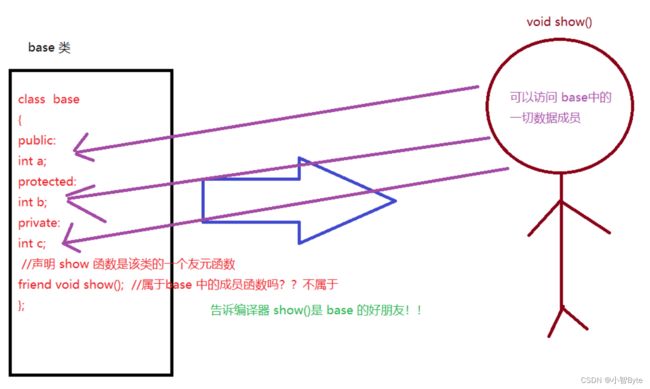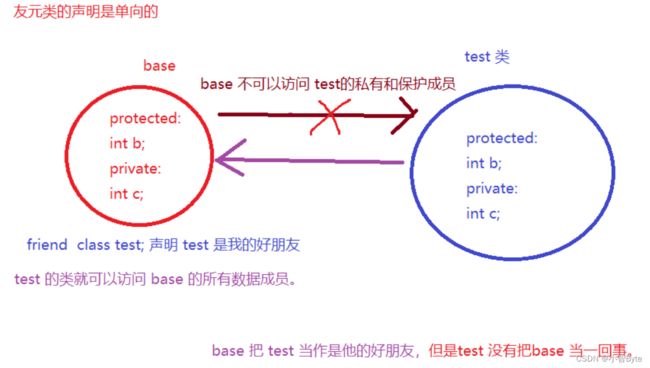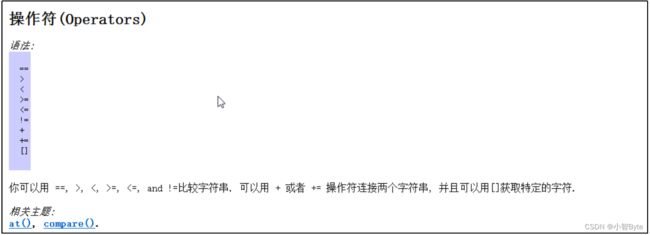6、C++中的友元与运算符重载
一、C++中的友元
1、C++中的访问权限
class base
{
public: //共有成员,类内,子类,类外,都可以访问
int a;
protected: //保护成员,类内,子类可以访问
int b;
private: //私有成员,类内可以访问
int c;
};
2、友元
- 作用:用于访问类中的所有成员
- 缺点:会破坏类的封装性,所以不要随便用友元
3、友元函数
语法:
friend 函数的返回值类型 函数名 (参数列表)
---------------------------------------
例子:
friend void show()//该函数就可以访问类中的所有成员
{
}
- 1、当一个函数被声明为友元函数时,该函数就不属于类中的成员函数
- 2、友元函数必须要在类内声明
- 3、友元函数可以在类内任意位置声明,与成员权限无关
#include 4、友元函数可以继承吗
class base
{
private:
int a;
//声明一个 set 友元函数
friend void set();
};
class new_base:public base
{
private:
int b;
//声明一个 set 友元函数
//friend void set();假设不重新声明友元函数就不能访问私有成员
};
void set()
{
base a;
a.a = 1000; //可以访问私有 成员
cout << a.a << endl;
new_base b;
b.b = 2000; //不可以访问 new_base 的私有成员。
}
- 1、友元函数是不可以继承的
- 2、假设需要友元函数可以访问子类的私有成员,则需要在子类中再次声明该函数为友元函数
- 3、多个类可以对应一个友元函数
- 4、一个类可以对应多个友元函数
二、友元类
作用:
- 当一个类为另一个类的友类时,则该类可以访问对方的所有数据成员
语法:
friend class 类名
----------------
例子:
friend class base;
#include 三、运算符重载
1、作用:
- 给已知的运算符赋予新的功能。比如:两个字符串的相加 , 两个类的相加,两个结构体的相加等。
语法:
返回类型 operator 运算符号 (参数列表)
------------------------------------
例子:重载两个类相加
base operator+(base a)
{
}
2、可重载运算符:
哪些运算能重载
双目运算符 (+,-,,/, %) operator+
关系运算符 (==, !=, <, >, <=, >=)
逻辑运算符 (||, &&, !)
单目运算符 (, &, ++, --)
位运算符 (|, &, ~, ^, <<, >>)
赋值运算符 (=, +=, -=, …)
空间申请运算符 (new , delete)
其他运算符 ((), ->, [])
3、不可重载运算符:
哪些运算符不能重载
.(成员访问运算符)
.*(成员指针访问运算符)
::(域运算符)
sizeof(数据类型长度运算符)
?:(条件运算符, 三目运算符)
4、运算符重载的两种方式
类内重载方式:
base operator+(参数列表)
调用规律:
base c = a + b; - > a.operator+(b)//两者等价
特点:
a是调用者,b是参数。
在类的内部重载,友this指针
类外重载方式:
base operator+(base a, base b)
调用规律:
base c = a + b; -> operator+(a, b)//两者等价
特点:
a和b都是operator的参数,可以不用this指针
总结:
- 这两种重载运算符的方式都是一样的,用户根据自己的需要选择
四、不同运算符重载的方式
1、关系运算符:
#include 2、逻辑运算符
#include 3、单目运算符
#include 利用位运算符 << , >>实现输入输出的重载
1、输出运算符的重载
#include 2、输入运算符的重载
#include 五、字符串类的使用
构造函数
// 默认构造函数,创建一个空字符串
string();
// 构造函数,以指定字符重复构造字符串
string(size_type length, char ch);
// 构造函数,以C风格字符串创建字符串
string(const char *str);
// 构造函数,从C风格字符串中指定位置和长度创建字符串
string(const char *str, size_type length);
// 构造函数,从另一个字符串截取子串
string(string &str, size_type index, size_type length);



